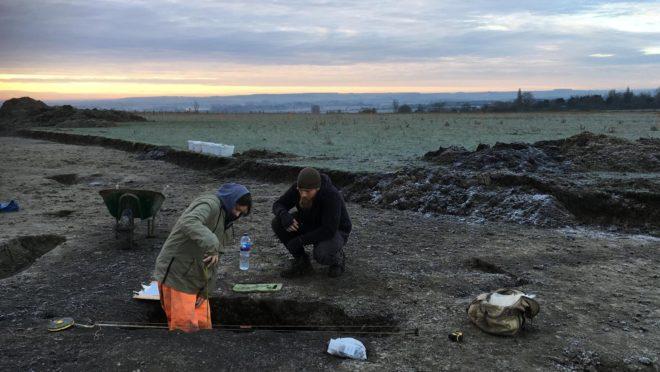The site of Wittenham was already famous for the rich prehistoric and ancient vestiges of its fortified hills, it will be even more so, from now on, for the agglomeration of the Iron Age unearthed at their foot by a team of English archaeologists .
In the shadow of the two hills located in the hinterland of Oxford, on the edge of the Thames, excavations which have just been completed after three years of toil have revealed the presence of a large Roman villa.
Dating from the end of the 3rd - beginning of the 4th century BC.
AD, it was built on top of at least fifteen older dwellings, themselves occupied from the 4th to the 2nd century BC.
J.-C ..
Read also: An exceptional necropolis from late Antiquity discovered in Cambridge
Far from being simple huts, the discovery of traces of plaster suggests that at least part of these houses had to be painted.
Circular in type, the average diameter of these dwellings was about 10 m, which, as the archaeological company Dig Ventures in charge of the excavation recalled, corresponds roughly to an area of 78 m², i.e. more than the average UK accommodation.
These homes also had an elaborate gutter system.
A structure dedicated to food storage has also been identified.
The Roman villa, at least 30 m long and adorned with colonnades of which some bases have been found, was built on the same site as the agglomeration of the Iron Age, several centuries after its abandonment.
Although about a quarter of the estate has been excavated, there is already no doubt for archaeologists that it was a rich agricultural property.
The occupancy levels corresponding to the Roman era have also yielded a large volume of common objects and small furniture, such as crockery, kitchen utensils, an ointment spatula, decorated bone combs.
Around the villa, at least 42 Roman tombs have been identified, as well as various structures and remains linked to the agricultural activity of the site: a grain dryer, an oven, traces of charred wheat and barley.
“We believe this is a site that has been continuously occupied from the mid-Iron Age to the Roman period,”
excavation director Chris Casswell said in a statement.
“There could also have been a few brief interruptions,”
he added.
1/4 - The site of the villa from the 3rd-4th century AD.
J.-C .. Dig Ventures
2/4 - The outline of the cirucled habitat of the Iron Age is identifiable by its post holes.
Dig Ventures
3/4 - A Roman comb.
Dig Ventures
4/4 - Some of the common crockery from the Roman period found on the site.
Dig Ventures
Read also: Discovering the forgotten Roman villas on the slopes of Vesuvius
A larger site than expected
Neither very striking in itself, nor even very old since the site was frequented from the Bronze Age, the remains discovered took archaeologists by surprise by their extent and density.
“It is not surprising to find habitat here, given the proximity to the hill;
it's the sheer scale of it that is impressive, ”
said Chris Casswell.
“We didn't expect to find so many houses in such a small space - the area we searched is a little over a hectare while the built-up area itself was clearly much larger.
And so far we have only excavated part of it,
he said enthusiastically.
Most surprisingly, almost nothing appeared during the first geophysical survey, probably due to an anomaly in the local geology.
It wasn't until we started digging that we were able to reveal the true extent of what is here.
"
Read also: Four 1st century Gallic busts discovered in Brittany
Discovering an important site where you might not have expected it is one of the joys of the job.
"You're never really sure,"
archaeologist Lisa Westcott Wilkins testified for the
Guardian
.
“
We actually thought we would find traces of habitat there, but honestly we are the first surprised at the amount of everyday and real life remains of people that we have found.
It was one of those digs where you almost felt like you could touch them. ”
The end of the occupation of the site, in the 4th century AD.
AD is marked by the abandonment of the Roman villa and the reuse of its materials.
A symbolic return to the ancient sources of Wittenham should complete the developments under construction near the fortified hills since the neighboring land will host, in the coming years, a reconstruction of the portion of the protohistoric village discovered.
One way to pay tribute to the work of archaeologists and the former occupants of the site.













